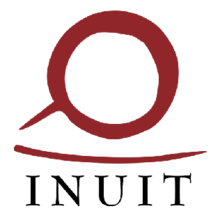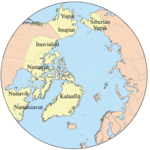Inuit Circumpolar Council
Inuit Circumpolar Council
| |
 The logo of the Inuit Circumpolar Council Stylised motif of a frame drum with a handle and a stick | |
 Member states and regions of the Inuit Circumpolar Council. | |
| Abbreviation | ICC |
|---|---|
| Formation | June 1980 |
| Founded at | Nuuk, Greenland |
| Type | Inter- and multinational non-governmental organization (NGO) |
| Legal status | active |
| Purpose | To promote and to ensure rights, interests, and the development of Inuit culture and languages. |
| Headquarters | Anchorage, Alaska Ottawa, Canada Nuuk, Greenland Anadyr, Russia |
Region served | 4 regions
|
Membership | 180,000 |
Official languages | English, French |
Chair of the Inuit Circumpolar Council | Sara Olsvig[1] |
Vice-Chairs of the Inuit Circumpolar Council | President of ICC Alaska Marie Greene President of ICC Canada Lisa Qiluqqi Koperqualuk President of ICC Greenland Kuupik V. Kleist President of ICC Russia Irina Mishina[1] |
Main organ | ICC International |
| Website | www |
| Part of a series on |
| Indigenous rights |
|---|
| Rights |
| Governmental organizations |
| United Nations initiatives |
| International Treaties |
| NGOs and political groups |
| Issues |
| Countries |
| Category |
The Inuit Circumpolar Council (ICC; Greenlandic: Inuit Issittormiut Siunnersuisooqatigiiffiat; formerly the Inuit Circumpolar Conference) is a multinational non-governmental organization (NGO) and Indigenous Peoples' Organization (IPO) representing the 180,000 Inuit and Yupik (sometimes referred to as Eskimo) people living in Alaska (United States), Canada, Greenland (Kingdom of Denmark), and the Chukchi Peninsula (Chukotka Autonomous Okrug, Russia).[2] ICC was ECOSOC-accredited and was granted special consultative status (category II) at the UN in 1983.
The Conference, which first met in June 1977 in Barrow, Alaska (now Utqiaġvik), initially represented Native Peoples from Canada, Alaska and Greenland. In 1980 the charter and by-laws of ICC were adopted. The Conference agreed to replace the term Eskimo with the term Inuit. This has not however met with widespread acceptance by some groups, most pre-eminently the Yupik (see Background section below). The goals of the Conference are to strengthen ties between Arctic people and to promote human, cultural, political and environmental rights and polities at the international level.[3]
ICC holds a General Assembly every four years. ICC is one of the six Arctic indigenous communities to have the status of Permanent Participant on the Arctic Council.
Background
[edit]The Inuit population includes the following groups and regions:[2]
- Canada: Inuit Nunangat: Central Inuit (Nunavut), Inuvialuit (Inuvialuit Settlement Region, Northwest Territories), Nunavimmiut (Nunavik, Nord-du-Québec), and Nunatsiavummiut or Labradormiut (Nunatsiavut, Labrador)
- United States (Alaska): Iñupiat, Yup'ik (Central Yup’ik & Cup’ik), and Siberian Yupik (St. Lawrence Island Yupik)[4]
- Greenland: Greenlandic Inuit: Kalaallit, Inughuit, and Tunumiit
- Russia: Siberian Yupik (Chukchi Peninsula, Chukotka)
All of these peoples are sometimes collectively referred to by the exonym Eskimo, the use of which is frowned upon by many of the Inuit, especially in eastern Canada. ICC uses the term Inuit to refer to them all, which has its own problems. One of those is administrative: an Inuk in the United States could be considered "Native American," "Alaskan Native" or "Aboriginal American." The Yupik of both Alaska and Russia generally prefer being called Yupik. Inuit is currently used in Alaska but it is not a word in the Yupik languages, nor a word which they traditionally used to describe themselves. Eskimo, which was formerly used in Alaska is generally dying out.[5]
Structure and functions
[edit]The main goals of the organization are to strengthen unity among Inuit, to promote their human rights (Indigenous and linguistic) and interests, and to ensure the development of Inuit culture.
Structurally, the organization is made up of four separate offices in each of the four Inuit nations, chartered individually under their national rules. The Presidents of ICC Chukotka, ICC Alaska, ICC Canada, and ICC Greenland, along with one Executive Council Member elected from each of the nations, make up the eight-member ICC Executive Council. The Executive Council is presided over by an International Chair (formerly International President—the title was changed in 2002).
ICC holds a General Assembly every four years, bringing together Inuit from across the northern circumpolar region to discuss issues of international importance to their communities, provide direction for the work of the organization over the next four years, and divide responsibility for issue areas between the national offices. Assembly delegates appoint an international chair from the General Assembly host-country, along with the members of the Executive Council, and develop policies and resolutions for the coming term.
The General Assembly, and thus the International Chair position, rotates between the four Inuit nations quadrennially at the General Assemblies. At the 2002 General Assembly in Kuujjuaq, Nunavik, Canada, the Chair passed from Greenland, where it had been held for the previous seven years by Aqqaluk Lynge, now a member of the United Nations Permanent Forum on Indigenous Issues, to Canada, where Sheila Watt-Cloutier, formerly the President of ICC Canada, took the position.
In 2006, the Chair passed to ICC Alaska at the General Assembly in Barrow, and was then occupied by Patricia L. Cochran, formerly executive director of the Alaska Native Science Commission. At that Assembly, ICC also voted to change its name to Inuit Circumpolar Council as there has been perennial confusion over an organizational name that sounds more like a past meeting.[1]
Leadership
[edit]The leadership of the ICC was initially organized with one president and three regional vice presidents. A fourth vice-president was added when Russia/Chukotka joined the ICC. The president later came to be unknown as chairperson or international chairperson.
| Session | International | Canada | Greenland | Alaska | Chukotka |
|---|---|---|---|---|---|
| 1980-1983 | Hans-Pavia Rosing | Mary Simon | Aqqaluk Lynge | James Stotts | n/a |
| 1983-1986 | Hans-Pavia Rosing | Mark Gordon | Aqqaluk Lynge | James Stotts | n/a |
| 1986–1989 | Mary Simon | Rosemarie Kuptana | Aqqaluk Lynge | Caleb Pungowiyi | n/a |
| 1989-1992 | Mary Simon | Les Carpenter | Aqqaluk Lynge | Edna McLean | Alexander Omrypkir & Nadezda Sudakova (Ex-officio) |
| 1992-1995 | Eileen MacLean (1992-1993) Caleb Pungowiyi (1993-1995) | Minnie Grey | Ingmar Egede | Gloria Simeon | Zoya Ivanova |
| 1995-1998 | Rosemarie Kuptana (1995-1997) Aqqaluk Lynge (1997-1998) | Sheila Watt-Cloutier | Aqqaluk Lynge | Ronald Brower | Tatiana Achirgina |
| 1998-2002 | Aqqaluk Lynge | Sheila Watt-Cloutier | Alfred Jakobsen (1998-1999) Uusaqqak Qujaukitsoq (1999-2002) | Dennis Tiepelman | Lubov Otrokova |
| 2002-2006 | Sheila Watt-Cloutier | Duane Smith | Aqqaluk Lynge | Chuck Greene | Natalia Rodionova |
| 2006-2010 | Patricia Cochran (2006-2009) Jimmy Stotts (2009-2010) | Duane Smith | Aqqaluk Lynge | Chuck Greene | Tatiana Achirgina |
| 2010-2014 | Duane Smith | Carl Christian “Puju” Olsen | James Stotts | Tatiana Achirgina | |
| 2014-2018 | Okalik Eegeesiak | Duane Smith (2014-2016) Nancy Karetak Lindell (2016-2018) | Hjalmar Dahl | James Stotts | Tatiana Achirgina |
| 2018-2022 | Dalee Sambo Dorough | Monica Ell-Kanayuk | Hjalmar Dahl | James Stotts | Liubov Taian |
| 2022-2026 | Sara Olsvig | Lisa Qiluqqi Koperqualuk | Kuupik Kleist (2022-2023) Hjalmar Dahl (2023-2026) | Marie Greene | Egor Vereshagin |
See also
[edit]- Arctic Council
- Saami Council
- West Nordic Council
- Arctic cooperation and politics
- United Nations Permanent Forum on Indigenous Issues
- International Day of the World's Indigenous Peoples
- Working Group on Indigenous Populations
- Indigenous and Tribal Populations Convention, 1957
- Indigenous and Tribal Peoples Convention
- Declaration on the Rights of Indigenous Peoples
References
[edit]- ^ a b c "ICC Executive Council Members". 3 January 2019. Retrieved 2022-08-13.
- ^ a b "ICC Charter". www.inuitcircumpolar.com. Inuit Circumpolar Council. Retrieved 2024-04-23.
"Inuit" means indigenous members of the Inuit homeland recognized by Inuit as being members of their people and shall include the Inupiat, Yupik (Alaska), Inuit, Inuvialuit (Canada), Kalaallit (Greenland) and Yupik (Russia).
- ^ Pound, Richard W. (2005). 'Fitzhenry and Whiteside Book of Canadian Facts and Dates'. Fitzhenry and Whiteside.
- ^ "ICC Alaska - About". Retrieved 16 May 2024.
- ^ Kaplan, Lawrence. "Inuit or Eskimo: Which name to use?". www.uaf.edu. Alaska Native Language Center, University of Alaska Fairbanks. Retrieved 2021-04-02.
- ^ "Who's who at ICC: ICC Executive Council Members, 1977 to present". Inuit Circumpolar Council Canada. 13 December 2023.


 French
French Deutsch
Deutsch